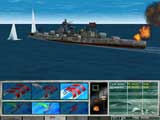 |
|
|
 Picture yourself on the conning
tower of one of the seagoing juggernauts of World War II – massive deck-mounted guns
blasting shell after shell, pounding the enemy’s hull with every shot; torpedoes
propelling from their tubes, speeding their way toward their target; machinegun fire
spraying the deck of the enemy ship… SSI’s latest naval combat release, Fighting
Steel, eases you into the
role of commander of a group of
these nautical giants and combines intensity, realism, and historical accuracy
into a remarkable RTS simulation. Picture yourself on the conning
tower of one of the seagoing juggernauts of World War II – massive deck-mounted guns
blasting shell after shell, pounding the enemy’s hull with every shot; torpedoes
propelling from their tubes, speeding their way toward their target; machinegun fire
spraying the deck of the enemy ship… SSI’s latest naval combat release, Fighting
Steel, eases you into the
role of commander of a group of
these nautical giants and combines intensity, realism, and historical accuracy
into a remarkable RTS simulation.Fighting Steel’s graphics are, for the most part, very impressive. FS allows you to toggle between a very aesthetically pleasing 3-D mode and a plain-yet-practical 2-D layout. The 3-D perspective provides beautiful, detailed ship models, all the way down to rotating turrets and moving wakes behind each ship. And the battle animations are amazing. Explosions, star shells, searchlights, and cannon fire light up the screen, while weather conditions and smokescreens bring even more realism to the battles. While not as pretty as the 3-D option, the 2-D grid often makes it easy to see what’s happening in the scenario. It can be a little complex, but is often much easier to deal with than its 3-D component.
One nice aspect of Fighting Steel is that there is a lot of variety. FS allows you to play as a commander for one of four different navies: American, British, Japanese, and German. Altogether, over one thousand ships from ninety different classes are yours to choose from. Combine this with a nice variety of campaign, scenario, and multiplayer missions and you’ve got yourself some playing time. Campaigns range in length from very short to very long, with several lengths in between. I didn’t get a chance to try the multiplayer option, but it looks to be very promising.
But a game with this much realism, playability, variety, and detail can’t be without some flaws, and Fighting Steel is no exception. There are more than a few drawbacks to the overall design of FS. One of the biggest problems I have with the game is that there are no submarines or fighter planes. Also, there is no land to be seen; only miles and miles of ocean. Though SSI gives reason s for both of these omissions in the game manual, I still find it to be a drawback to the overall realism the game provides.
But my biggest complaint about the game, though, was its stability problem. Fresh out of the box, Fighting Steel crashed all the time. It’s really lousy when, in the middle of turning a pair of German destroyers into Swiss cheese, the taskbar appears along with the rest of the Windows layout. Luckily, though, SSI has released 3 patches for the game. Since patching the game, however, it has played much more smoothly.
|